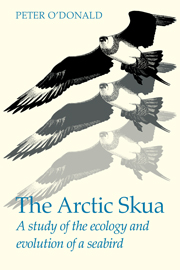Book contents
- Frontmatter
- Contents
- List of figures
- List of tables
- Preface
- 1 The Arctic Skuas of Fair Isle
- 2 Numbers and distribution
- 3 Feeding behaviour and ecology
- 4 Breeding ecology
- 5 Genetics
- 6 Demography and selection
- 7 Sexual behaviour
- 8 Sexual selection
- 9 Genetic models of sexual selection in birds
- 10 Mating preferences of the Arctic Skua
- 11 Conclusions
- Appendix A Rates of increase of bird populations
- Appendix B Analysis of variance of a 2 × r table with unequal numbers of observations
- Appendix C Statistical analysis of assortative and disassortative mating in polymorphic birds
- References
- Index
2 - Numbers and distribution
Published online by Cambridge University Press: 21 May 2010
- Frontmatter
- Contents
- List of figures
- List of tables
- Preface
- 1 The Arctic Skuas of Fair Isle
- 2 Numbers and distribution
- 3 Feeding behaviour and ecology
- 4 Breeding ecology
- 5 Genetics
- 6 Demography and selection
- 7 Sexual behaviour
- 8 Sexual selection
- 9 Genetic models of sexual selection in birds
- 10 Mating preferences of the Arctic Skua
- 11 Conclusions
- Appendix A Rates of increase of bird populations
- Appendix B Analysis of variance of a 2 × r table with unequal numbers of observations
- Appendix C Statistical analysis of assortative and disassortative mating in polymorphic birds
- References
- Index
Summary
Surveys of breeding colonies
Like many birds, Arctic Skuas can be observed and counted fairly easily on their breeding grounds. Breeding birds have been counted at many different colonies in the last 50 years. After the breeding season is over, they can be counted at points along their routes of migration. Counts of numbers of migrating birds give rough estimates of the relative proportions migrating along different routes, but no estimates of population sizes. Even in a breeding colony, numbers are difficult to estimate accurately. There are several sources of error. Estimates are usually too low. The exact number of breeding birds in a population can be determined only by surveying and marking all the nests as they are found. The survey must be repeated every two or three days throughout the period when the birds are incubating their eggs.
On Fair Isle, the first eggs are usually laid on 16 May. The last eggs may be laid on about 25 June, 40 days later. If a survey were carried out at the end of May, little more than half the pairs would be found. If a survey were carried out on about 20 July, when the last eggs were hatching, about half the pairs would already have fledged their chicks. They would no longer be defending their territories or feigning injury at the approach of an intruder. Many of the pairs would then be very difficult to ascertain.
- Type
- Chapter
- Information
- The Arctic SkuaA study of the ecology and evolution of a seabird, pp. 32 - 59Publisher: Cambridge University PressPrint publication year: 1983



